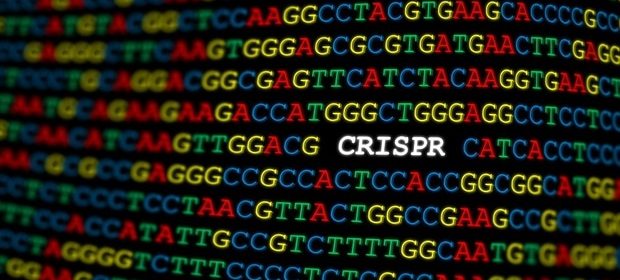New type of CRISPR gene scissors discovered

Like humans, bacteria and archaea can be attacked by viruses. These microorganisms have developed their own immune defense strategies against their pathogens. Bacterial defenses, such as CRISPR-Cas systems, have diverse proteins and functions that help bacteria protect themselves against foreign invaders. The defense is based on a common mechanism: a CRISPR ribonucleic acid (crRNA), serving as a "guide RNA," helps detect regions of a foreign genome, such as the DNA of a virus, for targeted cleavage. The CRISPR-associated (Cas) nuclease directed by a crRNA can cut its target like a pair of scissors: a strategy of nature that humans have harnessed in many technologies.
"Considering how well different nucleases have been translated into new and improved technologies, any discovery in this field could bring new benefits to society," says Chase Beisel, describing a research motivation of his laboratory at the Würzburg Helmholtz Institute for RNA-based Infection Research (HIRI). The institute is a site of the Braunschweig Helmholtz Centre for Infection Research in cooperation with the Julius-Maximilians-Universität (JMU) in Würzburg. Beisel initiated the current study on a specific set of CRISPR-Cas systems with Matthew Begemann at Benson Hill, Inc. (Missouri) and Ryan Jackson at Utah State University in the U.S. The results were published today in the renowned journal Nature and were accompanied by detailed structural analysis from a second team, also led by Ryan Jackson, and by David Taylor at University of Texas.
Unique from any other known CRISPR nuclease
We were exploring CRISPR nucleases that were originally clumped with Cas12a, nucleases that defend bacteria by recognizing and cleaving invasive DNA. Once we identified more of them, we realized that they were different enough from Cas12a to warrant a deeper dive. This exploration led us to discover that these nucleases, which we called Cas12a2, do something very different not only from Cas12a but also from any other known CRISPR nuclease."
Oleg Dmytrenko, first author of the study
The crucial difference lies in the mechanism of their defense action. When Cas12a2 recognizes invasive RNA, the nuclease cleaves it but can also damage other RNA and DNA inside the cell, impairing its growth and limiting the spread of the infection. "In general, such defense strategies that abort the infection have been known in bacteria," says HIRI postdoc Oleg Dmytrenko. "A few other CRISPR-Cas systems work in this way. However, a CRISPR-based defense mechanism that relies on a single nuclease to recognize the invader and degrade cellular DNA and RNA has not been observed before," the scientist says.
The findings in detail
Antibodies eBook

The protein sequence and architecture of Cas12a2 discriminate this nuclease from Cas12a. Activated by a protospacer-flanking sequence (PFS), Cas12a2 recognizes target RNAs that are complementary to its guide RNA. Targeting RNA triggers collateral nucleic acid cleavage that degrades RNA, single-stranded DNA, and double-stranded DNA. This activity leads to cell arrest, presumably by damaging DNA and RNA in the cell, which impairs growth. Cas12a2 can be used for molecular diagnostics and direct detection of RNA biomarkers, as demonstrated by proof-of-principle.
A destructive cleft
In further structural analysis of the nuclease by a second team that authored the companion paper in the same issue of Nature, Cas12a2 was shown to undergo major structural changes after binding to its RNA target at various stages of the immune response. This, in turn, leads to an exposed cleft in the nuclease that can shred any nucleic acid it encounters – be it RNA, single-stranded DNA or double-stranded DNA. The research also discovered ways to mutate Cas12a2 to alter the nucleic acid that the nuclease degrades after recognizing its RNA target. These specifics open up potentially broad technological applications for the future.
Funding
The study was supported by funding from the European Research Council (ERC Consolidator Award to Chase Beisel), the German Federal Agency for Disruptive Innovation (SPRIND), the Pre-4D program of the Helmholtz Centre for Infection Research, and with funds from the National Institutes of Health and the Welch Foundation.
University of Würzburg
Dmytrenko O, Neumann GC, Hallmark T, Keiser DJ, Crowley VM, Vialetto E, Mougiakos I, Wandera KG, Domgaard H, Weber J, Gaudin T, Metcalf J, Gray BN, Begemann MB, Jackson RN, Beisel CL (2023). Cas12a2 elicits abortive infection via RNA-triggered destruction of dsDNA. Nature, DOI: 10.1038/s41586-022-05559-3, https://www.nature.com/articles/s41586-022-05559-3
Bravo JPK, Hallmark T, Naegle B, Beisel CL, Jackson RN, Taylor DW (2023). Large-scale structural rearrangements nleash indiscriminate nuclease activity by CRISPR-Cas12a2. Nature, DOI: 10.1038/s41586-022-05560-w, https://www.nature.com/articles/s41586-022-05560-w
Posted in: Cell Biology | Genomics
Tags: Archaea, Bacteria, Cell, CRISPR, Diagnostics, DNA, Genome, Immune Response, Laboratory, Molecular Diagnostics, Nuclease, Nucleic Acid, Protein, Research, Ribonucleic Acid, RNA, Virus
Source: Read Full Article